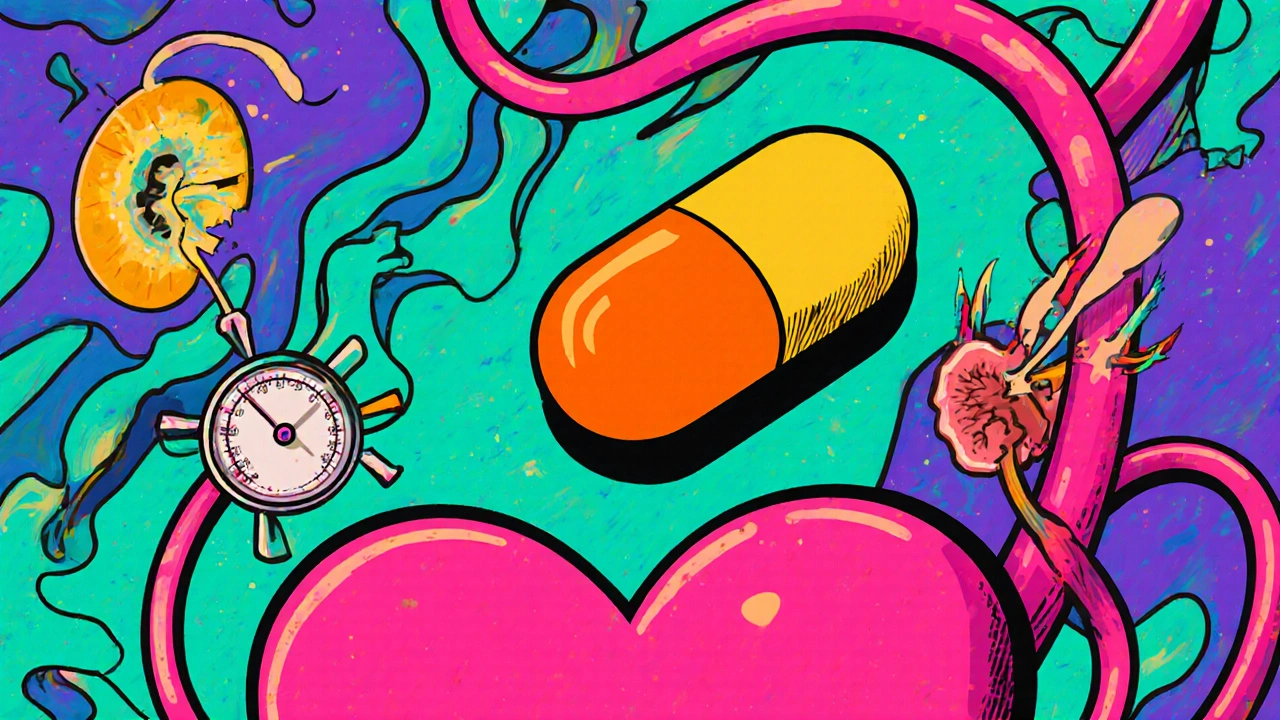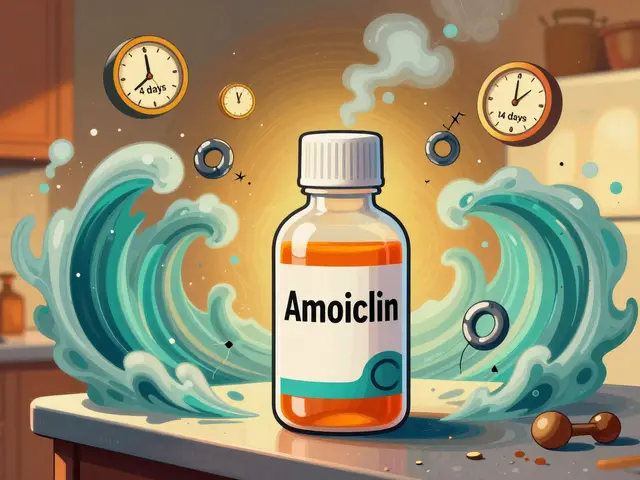
Irbesartan Allergy Symptom Checker
Allergy Symptom Assessment
This tool helps determine if your symptoms may be related to an Irbesartan allergy. Remember: If you experience difficulty breathing or throat swelling, seek emergency care immediately.
Select symptoms and click "Check Symptoms" to see guidance.
Quick Takeaways
- Irbesartan is an Irbesartan allergies‑related blood‑pressure pill that belongs to the ARB family.
- True allergic reactions are rare, but skin rash, itching, or swelling can happen.
- Watch for fast‑growing swelling of the lips, tongue, or throat - that could be angioedema.
- If you suspect a reaction, stop the drug and call your GP or go to A&E immediately.
- Switching to another ARB or an ACE‑inhibitor may be possible, but discuss cross‑reactivity with your doctor.
What Is Irbesartan?
Irbesartan is a prescription medication that belongs to the class of angiotensin II receptor blockers (ARBs). It works by relaxing blood vessels, which helps lower blood pressure and reduces the workload on the heart. The drug was first approved in the United States in 1997 and is now a common choice for managing hypertension and protecting the kidneys in people with type 2 diabetes.
How Irbesartan Works and What It’s Used For
Irbesartan blocks the action of angiotensin II, a hormone that narrows blood vessels. By preventing angiotensin II from binding to its receptors, the medication keeps arteries relaxed and improves blood flow. Because of this mechanism, doctors prescribe Irbesartan for:
- Essential (primary) hypertension.
- Diabetic nephropathy - slowing kidney damage in type 2 diabetes.
- Sometimes, heart‑failure management when other drugs are unsuitable.
Typical doses range from 75 mg to 300 mg once daily, taken with or without food. Blood‑pressure response is usually seen within a week, but full effect may take a month.
Can Irbesartan Trigger an Allergic Reaction?
All drugs have the potential to cause hypersensitivity, but the overall incidence of true IgE‑mediated allergy to Irbesartan is low-studies from the FDA and European Medicines Agency report rates under 0.1 % of users. Most reported “allergic‑type” events are actually side‑effects like mild rash or headache, not genuine immune‑driven allergies.
When an allergy does occur, it usually falls into one of two categories:
- Immediate‑type (IgE‑mediated) reactions: Hives, itching, swelling within minutes to a few hours after the first dose.
- Delayed‑type (cell‑mediated) reactions: Maculopapular rash or eosinophilic skin changes appearing days to weeks later.
One of the more serious, though still uncommon, presentations is angioedema - rapid swelling of deeper layers of the skin, often around the face, lips, or throat. While ACE inhibitors are notorious for angioedema, ARBs like Irbesartan can still cause it, especially in patients with a history of ACE‑inhibitor-induced swelling.

Spotting an Irbesartan Allergy: Symptoms to Watch
Because the reaction can be subtle, it helps to know the most common warning signs:
- Skin changes: Red, itchy patches, hives, or a widespread rash that isn’t explained by other causes.
- Swelling: Puffiness around the eyes, lips, tongue, or throat. If the swelling makes breathing or swallowing difficult, treat it as an emergency.
- Respiratory symptoms: Wheezing, shortness of breath, or a tight feeling in the chest after starting the drug.
- Systemic clues: Fever, joint pain, or a sudden drop in blood pressure (rare, but possible in severe anaphylaxis).
Timing matters. Immediate reactions usually occur within the first few doses, whereas delayed reactions might surface after weeks of consistent use. Keep a diary of any new skin or breathing issues that line up with Irbesartan start‑up.
What to Do If You Think You’re Allergic
Act quickly, but stay calm. Here’s a step‑by‑step plan:
- Stop the medication right away. Do not wait for the next scheduled dose.
- Assess severity. If you have trouble breathing, swelling of the throat, or feel faint, call 999 (or your local emergency number) immediately.
- Contact your GP or pharmacist as soon as possible. They can confirm whether the symptoms fit an allergic pattern and suggest an alternative.
- If the reaction was mild (e.g., a limited rash), your doctor may prescribe an antihistamine and monitor you for a few days while you stop Irbesartan.
- When you resume a blood‑pressure drug, a different ARB (like Losartan) or a calcium‑channel blocker may be safer, but always discuss cross‑reactivity.
Never restart Irbesartan on your own after a suspected allergy; re‑exposure can cause a more severe response.
Alternatives and Cross‑Reaction Risks
Switching to another antihypertensive is a common route, but some patients wonder if another ARB is safe. The data suggest that cross‑reactivity among ARBs is low-only about 1‑2 % of patients with an ARB allergy react to a second one. However, the risk rises if the original reaction was an angioedema, because the underlying bradykinin pathway can be shared.
Below is a quick comparison of three widely used ARBs, focusing on their reported allergy rates and typical side‑effects. The figures come from post‑marketing surveillance up to 2024.
| Drug | Allergy incidence (per 10,000 users) | Typical rash type | Angioedema risk |
|---|---|---|---|
| Irbesartan | 0.8 | Maculopapular, pruritic | Very low (≈0.1 %) |
| Losartan | 1.2 | Urticaria, mild edema | Low (≈0.2 %) |
| Telmisartan | 0.6 | Diffuse rash, occasional eosinophilia | Very low (≈0.05 %) |
When to Seek Immediate Medical Care
Most skin rashes are harmless, but certain signs demand urgent attention:
- Swelling of the tongue, lips, or throat that makes speech or swallowing difficult.
- Sudden drop in blood pressure (feeling dizzy, faint, or rapid heartbeat).
- Widespread hives accompanied by wheezing or shortness of breath.
- Any allergic reaction that begins less than five minutes after taking the pill.
These symptoms describe anaphylaxis, a life‑threatening emergency. Carrying an adrenaline auto‑injector is generally reserved for patients with a known severe drug allergy, but your GP can advise if that’s needed.
Managing the Underlying Condition Without Irbesartan
If Irbesartan must be discontinued, you’ll still need to control blood pressure. Options include:
- Calcium‑channel blockers (e.g., amlodipine) - effective and have a different side‑effect profile. \n
- Thiazide diuretics - work well for many patients, especially when combined with lifestyle changes.
- ACE inhibitors - useful unless you have a documented ACE‑inhibitor allergy or angioedema history.
- Lifestyle adjustments - low‑salt diet, regular exercise, weight management, and limiting alcohol.
Work with your healthcare team to titrate the new regimen and monitor blood‑pressure readings closely for the first few weeks.
Key Points to Remember
- Irbesartan is generally safe; true allergies are rare but possible.
- Early skin symptoms often precede more serious swelling; don’t ignore a new rash.
- Stop the drug and seek help if you notice any signs of angioedema.
- Switching to another ARB is usually fine, but discuss with a clinician if you had angioedema.
- Maintain regular blood‑pressure checks after any medication change.
Can I take Irbesartan if I have a history of drug allergies?
Yes, in most cases. Your doctor will weigh the severity of past reactions against the benefits of blood‑pressure control. If your previous allergy was mild and unrelated to the ARB class, Irbesartan can still be tried with close monitoring.
Is a rash always a sign of an allergic reaction?
Not always. Some rashes are side‑effects like photosensitivity or a drug‑induced exanthem that isn’t immune‑mediated. However, any new skin change after starting a medication deserves a quick check with your GP, especially if it itches or spreads.
How quickly can angioedema appear after a dose?
Angioedema can arise within minutes to a few hours of the first dose, but delayed cases have been reported up to 24 hours later. Immediate swelling of the face, lips, or throat is a red flag and requires emergency care.
If I stop Irbesartan, how long until my blood pressure rises again?
Blood‑pressure effects fade within 24‑48 hours after the last dose because the drug’s half‑life is about 12 hours. You’ll usually notice a gradual rise unless you start an alternative therapy promptly.
Are there any blood tests needed to confirm an Irbesartan allergy?
Allergy testing for drugs is tricky. Skin prick or intradermal tests are rarely used for ARBs. Most clinicians rely on clinical history and, in severe cases, a measured increase in serum eosinophils or IgE levels may support the diagnosis.






Natalie Morgan
October 20, 2025 AT 18:22Irbesartan is generally well tolerated but any new skin change should be noted. Keep a simple diary of when you start the medication and any rash that appears. Even mild itching can be a hint that your body is reacting. If you see swelling around the lips or tongue call your doctor right away. Staying proactive helps avoid a serious reaction.
Mahesh Upadhyay
October 23, 2025 AT 20:23Most people think drug allergies are rare, but they can be deadly. Ignoring a rash on a blood‑pressure pill is pure negligence.
Rajesh Myadam
October 26, 2025 AT 21:25I get why the reaction can feel alarming, especially when you’re managing hypertension. While it’s true that true IgE‑mediated allergies to Irbesartan are uncommon, the risk isn’t zero. The key is to differentiate a harmless side‑effect from a genuine allergic response. Light itching or a brief rash often resolves without intervention, but persistent or spreading lesions deserve attention. Swelling of the face, lips, or throat is a red flag and should trigger an emergency call. It’s also worth noting that cross‑reactivity with other ARBs is low, so your doctor can safely consider an alternative if needed. Keep track of timing – immediate reactions happen within hours, delayed ones may take days. A quick chat with your GP can clarify whether you need an antihistamine or a medication switch.
Kate McKay
October 29, 2025 AT 23:26Managing blood pressure is already a juggling act, so adding the worry of a possible allergy can feel overwhelming. Remember that most skin reactions are mild and manageable with over‑the‑counter antihistamines. If you ever notice swelling that makes it hard to speak or breathe, treat it as an emergency and head straight to A&E. Meanwhile, discuss with your clinician the option of a calcium‑channel blocker or a different ARB that has a lower reported rash rate. Staying on top of your readings and keeping a symptom log will give your doctor the best picture to adjust therapy safely.
Demetri Huyler
November 2, 2025 AT 01:27Honestly, the layman’s panic over a rare rash is overblown. Your GP can prescribe a suitable alternative without needing a daily diary. Let’s keep the drama out of pharmacology.
JessicaAnn Sutton
November 5, 2025 AT 03:29Any deviation from the protocol is unacceptable.
Israel Emory
November 8, 2025 AT 05:30First, let me acknowledge the anxiety that a potential drug allergy can cause; it’s a legitimate concern for anyone managing a chronic condition. Second, the pharmacodynamics of Irbesartan involve blocking angiotensin II receptors, which generally results in a favorable safety profile. Third, the incidence of true IgE‑mediated allergy is under 0.1 %, meaning the vast majority of users experience no immune reaction. Fourth, mild cutaneous manifestations such as pruritus or a transient maculopapular rash are often non‑immune side‑effects that resolve on their own. Fifth, clinicians differentiate these reactions by timing, distribution, and associated systemic symptoms. Sixth, immediate‑type reactions present within minutes to hours and may include urticaria, angio‑edema, or bronchospasm. Seventh, delayed‑type reactions appear days to weeks later and typically involve a widespread rash without respiratory compromise. Eighth, angio‑edema, though rare with ARBs, should never be ignored because airway obstruction can develop rapidly. Ninth, if you notice swelling of the tongue, lips, or throat, seek emergency care without hesitation. Tenth, a thorough medication history is essential to assess cross‑reactivity, especially if you have previously reacted to ACE inhibitors. Eleventh, switching to another ARB such as Losartan is often safe, but discuss it with your prescriber to evaluate the specific risk. Twelfth, alternative classes like calcium‑channel blockers or thiazide diuretics provide effective blood‑pressure control without involving the renin‑angiotensin system. Thirteenth, lifestyle modifications-low‑salt diet, regular exercise, and weight management-remain cornerstone interventions regardless of pharmacotherapy. Fourteenth, regular blood‑pressure monitoring after any medication change helps catch early signs of inadequate control. Finally, maintaining open communication with your healthcare team ensures that any adverse event is promptly identified and managed appropriately.
Sebastian Green
November 11, 2025 AT 07:31That was an exhaustive rundown, thank you. It helps to see the steps laid out clearly, especially the emphasis on when to call emergency services.
Wesley Humble
November 14, 2025 AT 09:33Statistically, the adverse‑event rate for Irbesartan‑induced angioedema hovers around 0.1 % across large cohorts, corroborating the low‑risk narrative presented in the literature.
barnabas jacob
November 17, 2025 AT 11:34Yo, if u got that itchy rash u prob need to check ur histamine cascade, no cap.
jessie cole
November 20, 2025 AT 13:36Stay calm and monitor; a rash can be scary but many resolve with an antihistamine and a quick doctor call.
Kirsten Youtsey
November 23, 2025 AT 15:37One must question the pharmaceutical narrative that downplays rare reactions while promoting mass prescriptions without transparent risk disclosure.
Matthew Hall
November 26, 2025 AT 17:22It’s like they want us all glued to pills while the side‑effects whisper in the shadows, waiting to strike when we least expect it.